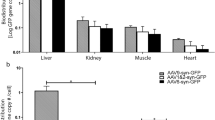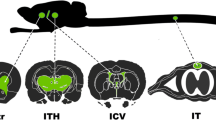Abstract
Nonviral gene delivery systems based upon polycation/plasmid DNA complexes are quickly gaining recognition as an alternative to viral gene vectors for their potential in avoiding immunogenicity and toxicity problems inherent in viral systems. We investigated in this study the feasibility of using a controlled release system based on DNA complexed with a recently developed polymeric gene carrier, polyaminoethyl propylene phosphate (PPE-EA), to achieve gene transfer in the brain. A unique feature of this gene delivery system is the biodegradability of PPE-EA, which can provide a sustained release of DNA at different rates depending on the charge ratio of the polymer to DNA. PPE-EA/DNA complexes, naked DNA, and DNA complexed with polyethylenimine (PEI), a nondegradable cationic polymer known to be an effective gene carrier, were injected intracisternally into the mouse cerebrospinal fluid. Transgene expression mediated by naked DNA was mainly detected in the brain stem, a region close to the injection site. With either PPE-EA or PEI as a carrier, higher levels of gene expression could be detected in the cerebral cortex, basal ganglia, and diencephalons. Transgene expression in the brain mediated by PPE-EA/DNA complexes at an N/P ratio of 2 persisted for at least 4 weeks, with a significant higher level than that produced by either naked plasmid DNA or PEI/DNA at the 4-week time point. Furthermore, PPE-EA displayed much lower toxicity in cultured neural cells as compared to PEI and did not cause detectable pathological changes in the central nervous system (CNS). The results established the potential of PPE-EA as a new and biocompatible gene carrier to achieve sustained gene expression in the CNS.
This is a preview of subscription content, access via your institution
Access options
Subscribe to this journal
Receive 12 print issues and online access
$259.00 per year
only $21.58 per issue
Buy this article
- Purchase on Springer Link
- Instant access to full article PDF
Prices may be subject to local taxes which are calculated during checkout





Similar content being viewed by others
References
Boussif O et al. A versatile vector for gene and oligonucleotide transfer into cells in culture and in vivo: polyethylenimine. Proc Natl Acad Sci USA 1995; 92: 7297–7302.
Godbey WT, Wu KK, Mikos AG . Poly(ethylenimine) and its role in gene delivery. J Control Rel 1999; 60: 149–160.
Lemkine GF, Demeneix BA . Polyethylenimines for in vivo gene delivery. Curr Opin Mol Ther 2001; 3: 178–182.
Kircheis R et al. Tumor targeting with surface-shielded ligand–polycation DNA complexes. J Control Rel 2001; 72: 165–170.
Abdallah B et al. A powerful nonviral vector for in vivo gene transfer into the adult mammalian brain: polyethylenimine. Hum Gene Ther 1996; 7: 1947–1954.
Lambert RC et al. Polyethylenimine-mediated DNA transfection of peripheral and central neurons in primary culture: probing Ca2+ channel structure and function with antisense oligonucleotides. Mol Cell Neurosci 1996; 7: 239–246.
Goula D et al. Size, diffusibility and transfection performance of linear PEI/DNA complexes in the mouse central nervous system. Gene Therapy 1998; 5: 712–717.
Wang S et al. Transgene expression in the brain stem effected by intramuscular injection of polyethylenimine/DNA complexes. Mol Ther 2001; 3: 658–664.
Shi L et al. Repeated intrathecal administration of plasmid DNA complexed with polyethylene glycol-grafted polyethylenimine led to prolonged transgene expression in the spinal cord. Gene Therapy 2003; 10: 1179–1188.
Godbey WT, Wu KK, Mikos AG . Tracking the intracellular path of poly(ethylenimine)/DNA complexes for gene delivery. Proc Natl Acad Sci USA 1999; 96: 5177–5181.
Godbey WT, Wu KK, Mikos AG . Poly(ethylenimine)-mediated gene delivery affects endothelial cell function and viability. Biomaterials 2001; 22: 471–480.
Wang J, Mao H-Q, Leong KW . A novel biodegradable gene carrier based on polyphosphoester. J Am Chem Soc 2001; 123: 9480–9481.
Wang J, P-C Zhang, Mao H-Q, Leong KW . Enhanced gene expression in mouse muscle by sustained release of plasmid DNA using PPE-EA as a carrier. Gene Therapy 2002; 9: 1254–1261.
Nguyen H-K et al. Evaluation of polyether–polyethyleneimine graft copolymers as gene transfer agents. Gene Therapy 2000; 7: 126–138.
Ogris M et al. PEGylated DNA/transferrin-PEI complexes: reduced interaction with blood components, extended circulation in blood and potential for systemic gene delivery. Gene Therapy 1999; 6: 595–605.
Hecker JG, Hall LL, Irion VR . Nonviral gene delivery to the lateral ventricles in rat brain: initial evidence for widespread distribution and expression in the central nervous system. Mol Ther 2001; 3: 375–384.
Driesse MJ et al. Intra-CSF administered recombinant adenovirus causes an immune response-mediated toxicity. Gene Therapy 2000; 7: 1401–1409.
Reijneveld JC, Taphoorn MJB, Voest EE . A simple mouse model for leptomeningeal metastases and repeated intrathecal therapy. J Neuro-Oncol 1999; 42: 137–142.
Acknowledgements
The work was funded by the Agency for Science, Technology and Research (A* STAR), Singapore to Institute of Bioengineering and Nanotechnology, Institute of Materials Research and Engineering, and Johns Hopkins Singapore.
Author information
Authors and Affiliations
Rights and permissions
About this article
Cite this article
Li, Y., Wang, J., Lee, C. et al. CNS gene transfer mediated by a novel controlled release system based on DNA complexes of degradable polycation PPE-EA: a comparison with polyethylenimine/DNA complexes. Gene Ther 11, 109–114 (2004). https://doi.org/10.1038/sj.gt.3302135
Received:
Accepted:
Published:
Issue Date:
DOI: https://doi.org/10.1038/sj.gt.3302135
Keywords
This article is cited by
-
CNS Delivery of Nucleic Acid Therapeutics: Beyond the Blood–Brain Barrier and Towards Specific Cellular Targeting
Pharmaceutical Research (2023)
-
Intrathecal Injection of Naked Plasmid DNA Provides Long-term Expression of Secreted Proteins
Molecular Therapy (2009)
-
Quantitative Comparison of Intracellular Unpacking Kinetics of Polyplexes by a Model Constructed From Quantum Dot-FRET
Molecular Therapy (2008)
-
Nonviral Approaches for Neuronal Delivery of Nucleic Acids
Pharmaceutical Research (2008)
-
The concept of molecular machinery is useful for design of stimuli-responsive gene delivery systems in the mammalian cell
Journal of Inclusion Phenomena and Macrocyclic Chemistry (2007)



